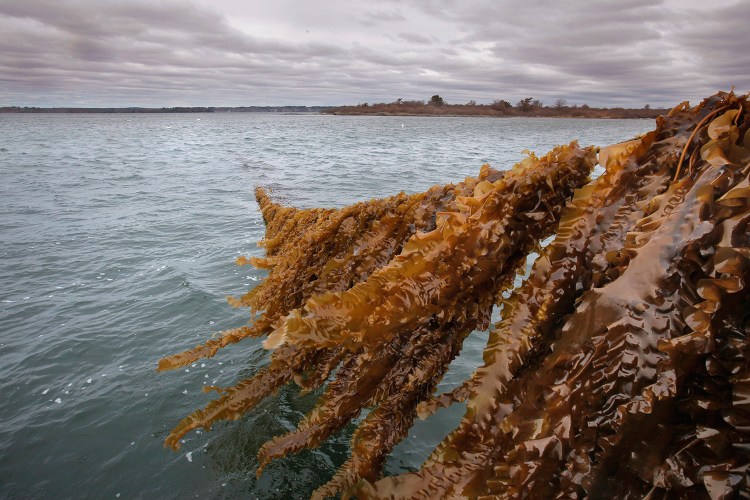The waters off Chebeague Island will be even greener than usual this winter.
Shearwater Ventures is moving in, joining another company, Portland-based Ocean Approved, in growing and harvesting seaweed in Casco Bay.
Nathan Johnson, who started Shearwater last year, just signed a state lease on nearly 4 acres of seabed. Johnson intends to grow sugar kelp, his foray into the $5 billion worldwide kelp industry.
Johnson, whose family has deep roots in the fishing industry in Maine, said he’s especially pleased that kelp farming can be done with little or no disturbance to other fisheries along the Maine coast.
“It’s going to be exciting to see the different ways the coastal economy can grow,” said Johnson, who lives on nearby Long Island and also works for Ocean Renewable Power Co. He also is a member of the board of trustees at the Island Institute.
Kelp grows readily on the coast of Maine, as anyone who has walked a beach in the state can attest. But only recently has it become recognized as a valuable addition to the state’s marine economy. Aquaculture was identified as one of the state’s three top industries – along with agriculture and biopharmaceuticals – that have the potential to grow and add value to Maine’s economy, according to a report written by McKinsey & Co. and commissioned by the economic development group FocusMaine.
Some kelp is wild-harvested, Johnson said, which essentially means it’s raked up from beaches on which the leafy sea plants wash up.
But kelp farming is just getting a toehold in the state. Johnson’s $100-an-acre annual lease is one of the first handed out by the state.
He said the process for farming kelp is relatively straightforward. A PVC tube is wrapped with up to 200 feet of a kite-size string that has kelp spores on it. Then a thicker line, similar to those used on lobster traps, is run through the tube and attached to the spore-lined kelp string. The two lines become entwined, with the spores “planting” themselves on the thicker line as they are eased into the water. Then the line is anchored on the sea floor and suspended by buoys while the kelp grows over the winter.
Johnson said the lines end up about 7 feet below the water surface, so they don’t interfere with boating or lobstermen heading out to tend their traps. Any interference between the kelp farming and the fishing industry is further minimized because kelp is “planted” in the fall and harvested in the spring, he said – the opposite of the spring and summer peak seasons for lobstering.
Kelp is a hardy plant, Johnson said.
“In the right conditions it can grow up to 5 inches a day,” he said, and the yield is often 10 pounds per foot of line, so 200 feet of line can yield a ton of kelp. This year, Johnson is putting in five 1,000-foot lines. The site can handle 15 lines, so he expects the small plot of seabed can yield a lot of kelp within a few years.
Initially, Johnson plans to sell his kelp to Ocean Approved, a local kelp-producing company that provides freshly frozen kelp to customers such as Portland’s Flatbread Co., which uses it in some of its salads.
“Kelp is the new kale,” Johnson said.
In addition to green salads, some restaurants are looking to turn kelp into a coleslaw type of dish, Johnson said, and it can also be processed into cubes that can be added to smoothies,
Other types of kelp can be used for biofuel, pharmaceuticals and cosmetics, Johnson said.
“The market is kind of a big unknown right now, but it’s an exciting time,” he said. “There are a lot of exciting opportunities.”
Johnson said the lease with the state is considered a three-year experiment, but if it works out, he will seek a longer-term deal that will keep him farming under Casco Bay.
Copy the Story Link
Send questions/comments to the editors.




Success. Please wait for the page to reload. If the page does not reload within 5 seconds, please refresh the page.
Enter your email and password to access comments.
Hi, to comment on stories you must . This profile is in addition to your subscription and website login.
Already have a commenting profile? .
Invalid username/password.
Please check your email to confirm and complete your registration.
Only subscribers are eligible to post comments. Please subscribe or login first for digital access. Here’s why.
Use the form below to reset your password. When you've submitted your account email, we will send an email with a reset code.